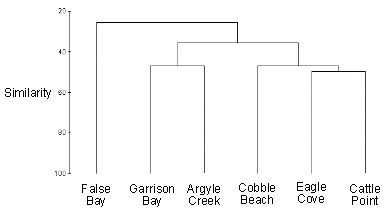
Overall Assemblage Comparisons
How different are the field sites with respect to their dominant faunas?
|
Number of Species
|
Percent of
Total Species |
Percent Unique
to Site |
|
|---|---|---|---|
| Eagle Cove |
109
|
64.05
|
23.08
|
| Cobble Beach |
61
|
36.09
|
10.06
|
| Garrison Bay |
36 |
21.30
|
2.96
|
| Cattle Point |
52
|
30.77
|
4.73
|
| False Bay |
35
|
20.71
|
7.10
|
| Argyle Creek |
45
|
26.63
|
2.96
|
| Total number of species |
169
|
-
|
-
|
|
A breakdown of the number of species that occur
at each field site, the proportion of the total species count that is
represented at each site, and the proportion that are exclusive to each
site.
|
This chart reflects some of the ecological differences among sites: the species richness (from the student counts) varies by nearly a factor of three between the most (Eagle Cove) and least species rich (False Bay) habitats. It is important to keep in mind that the sampling effort may have been different across the six sites. For example, some student groups may have focused carefully on finding a large number of different species, while other groups focused on examining the natural history of the most abundant or prominent species. The percentages of species exclusive to each site was strongly correlated with the overall species diversity, especially at Eagle Cove which had the largest number of species and the largest proportion of species not found elsewhere.
79 of the 169 total species reported were found at more than one site: Below is a chart of the number of species shared by pairs of field sites.
| Reference Habitat | Total Species | Eagle Cove | Cobble Beach | Garrison Bay | Cattle Point | False Bay | Argyle Creek |
|---|---|---|---|---|---|---|---|
| Eagle Cove | 109 | 39 | 22 | 39 | 16 | 35 | |
| Cobble Beach | 61 | 39 | 11 | 27 | 7 | 22 | |
| Garrison Bay | 36 | 22 | 11 | 12 | 15 | 19 | |
| Cattle Point | 52 | 39 | 27 | 12 | 9 | 11 | |
| False Bay | 35 | 16 | 7 | 15 | 9 | 11 | |
| Argyle Creek | 45 | 35 | 22 | 19 | 22 | 11 |
|
Total number of species in the reference
habitat.
|
These data may be converted to a measure of overall similarity:
| Eagle Cove | Cobble Beach | Garrison Bay | Cattle Point | False Bay | |
|---|---|---|---|---|---|
| Eagle Cove | |||||
| Cobble Beach | 45.88 | ||||
| Garrison Bay | 30.34 | 22.68 | |||
| Cattle Point | 49.68 | 47.78 | 27.27 | ||
| False Bay | 22.22 | 14.58 | 42.25 | 20.68 | |
| Argyle Creek | 45.45 | 41.50 | 46.91 | 45.36 | 27.5 |
|
Similarity matrix describing the relationship
among species assemblages at the six sites. Units should be read as
percent similarity. Generated using Primer5 software package.
|
These similarity figures may then be used to graphically describe the relative similarity among the six field sites using a branching tree diagram (like a genealogy): sites that are closely related to each other on the tree (such as Eagle Cove and Cattle Point) arise from a branch point with a high similarity score, while sites that are not alike (such as Garrison Bay and Cobble Beach) must trace their similarity back to a branch point with a relatively low similarity score:

Bray-Curtis similarity dendrogram of the six
habitats using presence/absence data for 169 species.
Generated using Primer5 software package.
This tree drawing (called a dendrogram) is
especially interesting because it reflects the quantitative differences
among the six sites, which many of the student researchers also noted
qualitatively: the three rocky sites are the most similar to one
another,
each being more exposed to wave action than the other three sites, and
having a similar slope with respect to tidal height. Garrison Bay and
Argyle Creek, though they differ in terms of substrate type (mud versus
rocky creek), are both
protected and far flatter than the rocky sites. Finally, False Bay is
the most different from any other field site with respect to its fauna,
as it is a very broad, soft-bottom habitat that contains a large
variety of sediment types.
The survey and this statistical analysis of its
results did not indicate strongly similar faunas at the two soft
sediment sites (Garrison Bay and False Bay). This seems surprising
because the two locations look similar (mud) and seem to have many
similar faunal elements (many burrowing bivalves and polychaete worms).
In part, the differences between them could reflect some more
particular differences between the two sediments: False Bay includes
more sand, and is flushed more vigorously by tidal action than Garrison
Bay, which has more very fine mud and clay plus a very rich upper layer
of diatoms. Perhaps as a result of such physical differences, the two
bays have some striking faunal differences in what are superficially
similar habitats (e.g., burrowing thallassinid shrimp in False Bay but
not Garrison Bay). The differences could also reflect different
sampling efforts by the student groups who studied the two sites. At
Garrison Bay, the specific mud site chosen for study was just a few
meters from a rocky outcropping where some typical rocky shore animals
(e.g., Nucella snails) were
found and included in the faunal survey. At False Bay, many similar
rocky outcroppings are present at the margins of the bay but were not
included by that student group because the rocks and their animals were
hundreds of meters away from the sediment areas that those students
focused on.
Comparative Assemblage Discussion
